First base is quite deep with talent as we look ahead to 2024, and it’s a position where you’ll need to decide quite quickly in drafts whether you want one of the top five guys as they could be off the board as soon as the start of the third round.
In drafts where I’ll be picking in the middle of the first round, I will likely end up with a lot of exposure to Freddie Freeman and his unbelievable combination of consistency and elite production. When I can’t land Freeman either because I’m picking too early or too late, there are a slew of targets in both the middle and late rounds of drafts that I’d be comfortable starting in standard leagues, so there’s no pressure to reach for a first baseman at any point in your draft unless you’re very married to the idea of a specific player.
As with all of the position ranking articles, these blurbs and ranks come from my Top 300 Hitters for Fantasy Baseball 2024 piece that also debuted today! Check that piece out for more on my rankings philosophy and, well, all the rest of my rankings.
Check out the Hacks & Jacks podcast featuring Scott Chu and Joe Gallina, which also happened to be a finalist for Best Baseball Podcast of 2021 by the Fantasy Sports Writers Association (FSWA)!
I also host an AMA in the r/fantasybaseball subreddit every Friday (starting sometime in late March) starting around noon ET that lasts through the rest of the day and into the weekend, so feel free to join the fun and ask questions or make comments.
Note: Catchers who have first-base eligibility were excluded from this specific set of rankings as you’ll never actually want to use any of them in that slot.
Tier 1
1. Freddie Freeman (1B, LAD) – Freddie Freeman hasn’t finished at the top of the first base standings since 2018, which sounds bad until I add in the fact that he’s finished in the top two at first base for six consecutive seasons. Freeman finished second at first base again in 2023, though he was also the third-best hitter overall so it’s not as though he wasn’t close. You won’t find a more consistent player, especially at first base where the top talent vastly outshines the middle tiers. The power rebounded in 2023, the ratios and counting stats stayed elite, and there’s nothing to indicate that 2024 will be any different. Make the safe pick and feel awesome about it.
2. Matt Olson (1B, ATL) – We knew Olson had power, but my goodness. Olson hit at least seven home runs every single month and did damage in just about every scenario against just about every type of pitcher all while maintaining a career-best walk rate and a solid strikeout rate. In most cases where we see big upticks in home runs, it’s something like an elevated fly ball rate or an increased pull rate, yet Olson’s fly ball rate was no different than usual and his pull rate was the lowest of his career. How did he do it? It’s shockingly simple, really—he just hit the ball harder. He did make better decisions too—especially at the end of the season—but he seemed to find another gear in terms of raw power. There are some potentially compelling explanations in the human side of the game, such as leaving the meaningless baseball wasteland of Oakland for the thriving competitive pastures of Atlanta, but all that matters is that we’ve recalibrated what “ceiling” means for Matt Olson and it’s “top-three overall hitter”.
3. Bryce Harper (1B, PHI) – Arguably, moving strictly to first base improves Harper’s value, as first base is not nearly as deep as outfield in standard formats—especially those requiring just three in the outfield. Harper missed time early in the season (though not as much as we thought he might) due to elbow surgery in the offseason, and it rather predictably led to a bit of a slow start in terms of power. As he continued to get further from his surgery date, Harper’s power began to return and by the end of the season, he was back to normal, as you can see in the rolling chart below. Durability will continue to be a concern until he strings together a few healthy seasons again, but when healthy, Harper is still one of the best run producers in baseball.
4. Vladimir Guerrero Jr. (1B, TOR) – It was a very disappointing season for Vladito as he failed to reach 30 home runs, 80 runs scored, or 95 RBI along with a lower-than-expected .264 batting average. Oddly, the Statcast data suggests he made better contact in 2023 than he did in 2022 despite the dip in actual production. Guerrero should bounce back from the rough campaign, though the further we get from his 2021 breakout, the more we have to question what to reasonably expect from a full season. He should put up numbers that are equal to (or better than) guys like Riley or Devers, but until he does it a second time, we have to have a bit of caution.
5. Pete Alonso (1B, NYM) – Alonso’s summer slump truly tanked his batting average, but the Polar Bear’s power was left unscathed as he blasted 46 home runs and drove in 118 runners. While that .217 batting average is certainly ugly, it’s not as though Alonso was striking out at unreasonable rates or popping out more than usual. I have a hard time finding anything that fully explains why the batting average took such a nosedive, which for a player with a track record like Alonso, means I am mostly disregarding it for 2024.
Tier 2
6. Paul Goldschmidt (1B, STL) – The plate discipline is still there and Goldschmidt should still be locked into the heart of the Cardinals order, but age may finally be catching up to the 36-year-old after posting his lowest 162-game season home run total since 2016. I think there’s a good chance to clear 25 home runs in another full season (Goldy hasn’t missed more than 11 games in a season since 2014), but we should probably recalibrate our expectations for batting average and stolen bases as he posted a 27th percentile speed according to Statcast. I don’t think he’ll be a dud in the ratio department, but it isn’t easy to hit .300 when you start to slow down physically.
7. Christian Walker (1B, ARI) – Make it back-to-back seasons with over 30 home runs and finishing inside the top 35 hitters for Walker, who should continue to see a boost in counting stats thanks to Arizona’s rise to relevance. The Diamondbacks may not have the deepest lineup out there, but Carroll and Marte should get on base often enough to give Walker a good chance to get to 100 RBI again to go along with his 30 home run floor. The second straight season of a sub-20% strikeout rate also means that his batting average should be more neutral than it is negative.
8. Nolan Jones (1B/OF, COL) – Jones was quite good for most of his 2023 debut (besides July), but he turned it on in September, posting a 16.4% walk rate, 21.1% strikeout rate, and a .349/.461/.651 line with seven home runs and 46 combined runs and RBI. The 21.1% strikeout rate is what stands out to me in this line, as Jones’s power was a known commodity from his prospect days, and landing in Colorado made it even more likely that his power would play to some degree. If Jones can take a step forward in his decision-making against breaking balls, we could see a new gear to his game that looks more like his September line, but I’m guessing we don’t get quite that good of a result. I’m thinking something like 25 home runs, another 20 stolen bases, and a volatile (but not necessarily bad) batting average with good-not-great counting stats on a bad Rockies offense.
9. Yandy Díaz (1B, TBR) – The 22 home runs were cool, but the elevated fly ball rate Díaz showed early in 2023 was an apparition, meaning those 22 reflect Díaz’s ceiling more than his baseline or floor. He should continue to score 90 or more runs and hit .300 or better at the top of the Rays lineup, though, so while a return to the top 30 hitters is a bit of a stretch, being in or around the top 50 hitters is quite feasible, and Yandy’s floor is exceptionally high thanks to his plate discipline and contact ability.
10. Josh Naylor (1B, CLE) – A drop in strikeout rate and groundball rate helped unlock more of Naylor’s potential, particularly when it comes to batting average. Runs may continue to be hard to come by with the extreme lack of depth in Cleveland (though the development of Bo Naylor and Manzardo could alleviate this to some extent), but 90-100 RBI should be in reach hitting fourth for this top-heavy lineup. Those counting stats plus about 20 home runs and a .285 or better batting average would be a nice addition to any fantasy squad.
11. Cody Bellinger (OF, FA) – It was a second breakout for Bellinger in 2023 as he set career bests in strikeout rate, batting average, and stolen bases while putting up his most productive season since 2019. These dramatic turnarounds are hard enough to process on their own, but when they come with a career-worst barrel rate, hard-hit rate, and average exit velocity, it’s nearly impossible. I can’t ignore the actual results, but the concerning underlying numbers leave me quite skeptical that Bellinger can repeat without actually changing what he is as a hitter—something we aren’t asking anyone else in the top 40 to do.
12. Spencer Torkelson (1B, DET) – The ratios continue to lag, but the power was on display in 2023 as Torkelson hit 31 home runs with 27 of those dingers coming on or after June 4th (106 games, which is a 41 home run pace over 162 games). Tork’s high flyball rate will likely keep his average from being more than neutral in spacious Comerica Park, but with this kind of power, he just needs to hit closer to .250 to unlock his fantasy potential. Some additional help around him would be nice, such as a healthy Greene and a free agent or two, as it would boost his counting stat potential. I love looking at this rolling chart of his power—it takes a special player to add more than double the number of expected extra bases for almost 100 batted balls.
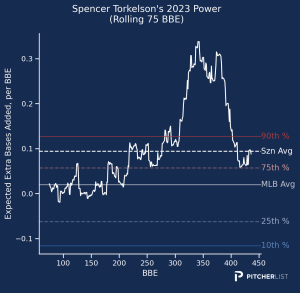
13. Triston Casas (1B, BOS) – Casas hit his stride in the second half, hitting 15 home runs while slashing .317/414/.617 with just a 23.7% strikeout rate. There’s 30+ home run power with Casas, and he was a strong decision-maker for all of 2023. If Casas can keep the Red Sox comfortable enough to start him against lefties, he should get enough plate appearances to get to 30 home runs and 90 RBI, but his extremely passive ways and his swing-and-miss issues against lefties present just enough of a risk that he falls a bit short. For what it’s worth, I think most folks will prefer Casas to Torkelson (especially in OBP leagues, where Casas is clearly the superior choice).
14. Nathaniel Lowe (1B, TEX) – The home runs and ratios went back to their 2021 levels, but on the plus side, so did the walk rate. Lowe should keep batting in the heart of the Texas lineup and get plenty of runs scored and RBI to go with 17-20 home runs and a .265 batting average. Those in OBP and points formats can probably move him up to the bottom of the previous tier due to the walks. It may not be exciting, but the steady and solid production Lowe provides should be more than enough to finish inside the top 80 hitters as he did in 2023, even without the big power we saw in 2022.
Tier 3
15. Isaac Paredes (1B/3B, TBR) – I have been on board for quite some time due to the hit tool and the way the Rays have used that skill and turned it into home runs. Despite the lower batting average, Paredes remains a guy who is excellent at making contact, and as long as he has an everyday role, I’m all in on another 28-30 home run season for Paredes and another 90+ RBI. I also believe he can repeat the .250 batting average due to his ability to avoid strikeouts and his willingness to take a walk rather than chase bad pitches.
Paredes happens to be an example of how expected stats can be misleading for players with specific skill sets. Baseball Savant’s expected batting average does not take batted ball direction into account because it is often fluky and year-to-year pull rates are not usually that sticky. That said, some players do make specific, intentional changes to their batted ball profile (like Paredes has), and it allows them to overperform those expected stats quite significantly.
16. Vinnie Pasquantino (1B, KCR) – Injuries cut his 2023 far too short, but with Pasquantino’s excellent plate discipline creating a high long-term floor for his ratios, the only question is how much power he can find in the major leagues. He has 19 home runs so far in his 133-game major league career, and while he did hit 28 home runs across triple-A and the majors in 2022, I think asking for more than 22-25 is asking for too much from Vinnie P, especially if the trend in the chart below continues. Assuming he returns to being a plus decision-maker, Vinnie P should be a high-floor, moderate-ceiling first baseman, which sets him apart from Torkelson and Casas who have higher ceilings thanks to their power but much lower floors due to their contact issues.
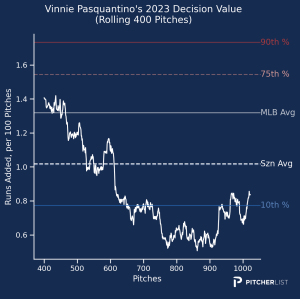
17. Rhys Hoskins (1B, MIL) – The 30-year-old slugger missed all of 2023 with a knee injury but Milwaukee was still surprisingly quick to scoop him up to be their primary first baseman. We know a healthy Hoskins is capable of 30 home runs with a .245 batting average, but injuries have now been major issues in two of the last three seasons. If he looks healthy in Spring Training, expect Hoskins to jump up significantly in these rankings, but until then, the health risk will hold him back.
18. Spencer Steer (1B/3B/OF, CIN) – Steer’s first full season in the big leagues went far better than anyone could have expected, with 23 home runs, 15 steals, and 160 combined runs and RBI with a .271/.356/.464 line. His average tailed off towards the end of the season, in part because pitchers started to challenge him less with hittable pitches (particularly breaking balls), but Steer responded well by showing he could make contact with the more difficult pitches.
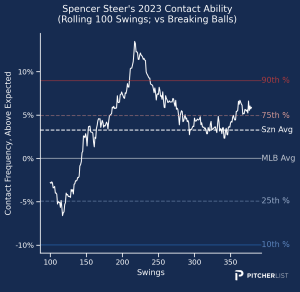
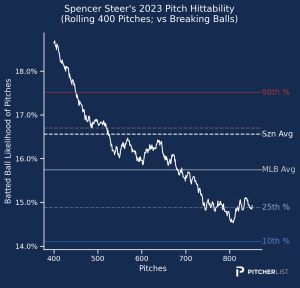
I’d be surprised if Steer repeated his 15 stolen bases as he never stole more than eight in a single season in the minor leagues (eight to 10 is a better starting point), but Steer shouldn’t have an issue clearing 20 home runs again with strong counting stats and his hit tool is good enough to post above-average ratios.
19. Alec Bohm (1B/3B, PHI) – 2023 is probably the peak of what Bohm can be: 20 home runs, 97 RBI, and a .274/.327/.437 line. At one point in time, Bohm was considered a power prospect who could hit 25-30 home runs, but his time in the majors has seen him shift into being a contact-oriented hitter with a subpar barrel rate and a low fly ball rate. He finished inside the top 75 hitters thanks to the boosted RBI, and if Turner, Harper, and Castellanos can look like they did in the second half of 2023 he could flirt with 100 RBI again. That said, Bohm’s limited power (especially against right-handed pitching) makes such a high total tough to reach and makes him more of a high-floor player than anything else.
Tier 4
20. Jeimer Candelario (1B/3B, CIN) – Candelario could not have asked to be dropped into a better position as he’ll be hitting in the middle of the order for the up-and-coming Reds with a secure, everyday role. He may not repeat the eight steals he had in 2023, but look for Candelario to match or beat his home run, runs scored, and RBI totals in Cincinnati and push for a finish inside the top-100 hitters. His ceiling and floor probably aren’t that far apart, but it’s of high enough quality that we don’t mind the lack of explosive upside.
21. Christian Encarnacion-Strand (1B, CIN) – The young slugger still has a lot of work to do on his decision-making, but the raw power started to shine towards the end of the season. Decision-making is a much more “learnable” skill than contact ability or power, so hopefully an offseason and more time with the big league club will get Encarnacion-Strand where he needs to be to unlock his peak 35+ home run power. Playing time is a huge issue due to the very crowded infield (especially at the corners) in Cincinnati, so for now CES remains a lottery ticket.
22. Andrew Vaughn (1B, CWS) – Vaughn has increased his home run, runs scored, and RBI totals in each of his three major league seasons, but that’s about where the good news ends for those who have waited for Vaughn to justify his former standing as a top 20 prospect.

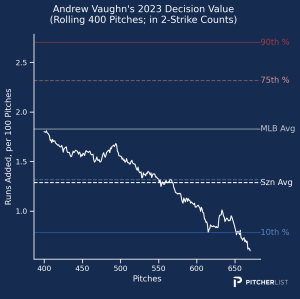
Vaughn is quite good at making contact and has slightly above-average power, but his rising aggression in 2023 led to lots of bad swing decisions, especially in two-strike counts. Unless he can find a way to make good decisions on a more consistent basis, the Vaughn we’ve seen in 2022 and 2023 is probably the Vaughn we’re going to continue to get. I’m holding out hope that there’s one more level to his game, but if we don’t see it in 2024, I’ll finally be ready to completely move on.
23. Brandon Drury (1B/2B, LAA) – So much for a power regression, eh? Drury only played in 125 games in 2023 but still managed to hit 26 home runs for the Angels as a follow-up to the 28 he hit back in 2022. I’m inclined to believe that the Drury we saw in 2022 and 2023 is the one we will get in 2024, and that means a .260 batting average, 25-27 home runs, and 150 combined runs and RBI over a full season.
Of course, Drury isn’t known for playing full seasons as he’s never played in 140 games in a season since going pro in 2010. He missed significant time in 2018, 2019, 2020, and 2021, so projecting more than 120 games is a big risk to take. That said, in shallow leagues, he remains an excellent back-end infielder who can provide power and RBI while batting in the heart of the order for a bad team.
Tier 5
24. Josh Bell (1B, MIA) – It may not always be pretty, but Bell once again found a way to drive in more than 70 runners and hit more than 20 home runs between his time with the Guardians and Marlins, with his best stretches coming with the latter. Bell will once again be a Marlin, and if he can recreate the 37.2% fly ball rate (which is about as high as it gets for Bell), we should see another 20+ home run season with improved counting stats. There’s also a chance he goes back to hitting grounders and becomes waiver material, but the 23-25 home run, 80 RBI upside with good ratios is worth gambling on as a late corner infielder.
25. Justin Turner (1B/2B/3B, TOR) – It was a great season on all accounts for the now-39-year-old Turner and he heads to the Blue Jays after setting career highs in runs scored and RBI. It’s hard to imagine there’s a lot of tread left on these tires, but Turner should get as much run as his body can handle in Toronto.
26. Jake Cronenworth (1B/2B, SDP) – Cronenworth could find his way back to the heart of the order with Soto now in New York, and hitting between some combination of Bogaerts, Machado, and Tatis is a good way to drive in 80 runners and score 80 runs. The batting average will likely be .240 or worse and he’s not likely to exceed 15 home runs, but Cronenworth should play enough to accumulate counting stats and be a high-floor, low-ceiling option for those in deeper formats.
27. Kyle Manzardo (1B, CLE) – Manzardo appeared to be one of the more polished minor league batters heading into the 2023 season. Injuries, personal issues, and bad luck led to some struggles and ultimately resulted in him being traded to Cleveland. Manzardo still utilizes a mature approach at the plate with a plus-hit tool and plus-power. Landing in Cleveland provides Manzardo with a much clearer path to playing time which should come as early as Opening Day. Manzardo has quickly turned into an underrated dynasty asset and is being overlooked for redraft leagues as well.
Here is what Steve wrote about Manzardo back in November:
“Manzardo looked to turn things around when he was traded to the Guardians and continued to get reps in the Arizona Fall League. Mazardo has looked closer to his old form, hitting five home runs in the AFL but still has yet to see his average creep back up to his 2022 season. A .269 BABIP for Tampa and .233 for Cleveland in 2023 may be the reason for this and Manzardo is still a top first base prospect.”
28. Wilmer Flores (1B/3B, SFG) –2023 was arguably the best season of Flores’ career and he enters 2024 as the number four hitter in the lineup and everyday DH. Free agents could muddle things up a bit depending on their skill set, but look for Flores to roughly 20 home runs with decent counting stats and a batting average around .260-.270.
29. José Abreu (1B, HOU) – I never really bought into Abreu in 2023 due to his lackluster 2022, but if the 37-year-old first baseman can find a path back to even a .250 batting average, he’s a threat to drive in 100 runners in the heart of the Houston lineup.
30. Anthony Rizzo (1B, NYY) – Rizzo folded after a hot start, slashing just .172/.271/.225 over the last 46 games he played before hitting the IL with a concussion. He was so bad that it was easy to forget that Rizzo had 11 home runs and a .305 batting average at the end of May, and there’s still a distinct likelihood that Rizzo starts the season as the number four hitter behind Judge and Soto. A return to the 30 home runs he hit in 2022 as a Yankee would easily get Rizzo to 100 RBI, but he’ll need to find health and consistency that just wasn’t there last season.
Photo by Rich Graessle/Icon Sportswire | Adapted by Justin Paradis (@JustParaDesigns on Twitter/X)
